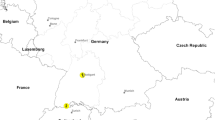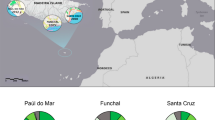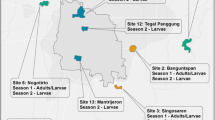Abstract
In recent years, the number of imported cases of arthropod-borne diseases in Europe, such as dengue fever, has increased steadily, as did the emergence and distribution of invasive insect vectors. Consequently, the risk of disease spreading into previously unaffected regions through invasive mosquitoes is also increasing. One example of an invasive mosquito is Aedes japonicus japonicus (A. j. japonicus), which spread from its original habitat in Japan to North America and Europe. This species has been shown to act as a vector for Japanese encephalitis and West Nile viruses. In Europe, A. j. japonicus has been detected in Switzerland, Belgium, Slovenia, and Germany, where it has become a resident species. Here, we describe the recent spread and genetic structure of A. j. japonicus populations in Germany. By monitoring the species in Baden-Württemberg in 2011 and 2012, we observed a considerable enlargement of the infested area from 54 municipalities in 2011 to 124 municipalities in 2012. To elucidate the colonization of Europe by A. j. japonicus, seven microsatellite loci were studied in 106 individuals sampled in Germany and Switzerland in 2012. The same markers were genotyped in 31 North American and 26 Japanese specimens. Population genetic analyses indicated that A. j. japonicus in Baden-Württemberg and North Rhine-Westphalia represented two genetically distinct populations with FST—values of 0.073–0.152, suggesting that they originated from two independent introduction events in the past. These results are of particular interest in light of vectorial variability for the transmission of viruses and other pathogens in Europe.



Similar content being viewed by others
References
Angelini R, Finarelli AC, Angelini P, Po C, Petropulacos K, Macini P, Fiorentini C, Fortuna C, Venturi G, Romi R, Majori G, Nicoletti L, Rezza G, Cassone A (2007) An outbreak of chikungunya fever in the province of Ravenna, Italy. Eur Surveill 12, E070906.1
Becker N, Pluskota B, Kaiser A (2011) Ochlerotatus japonicus japonicus—a newly established neozoan in Germany and a revised list of the German mosquito fauna. Eur Mosq Bull 29:88–102
Becker N, Geier M, Balczun C, Bradersen U, Huber K, Kiel E, Krüger A, Lühken R, Orendt C, Plenge-Bönig A, Rose A, Schaub GA, Tannich E (2013) Repeated introduction of Aedes albopictus into Germany, July to October 2012. Parasitol Res 112:1787–1790
Carrieri M, Bellini R, Maccaferri S, Gallo L, Maini S, Celli G (2008) Tolerance thresholds for Aedes albopictus and Aedes caspius in Italian urban areas. J Am Mosq Control Assoc 24:377–386
Dieringer D, Schlötterer C (2003) Microsatellite analyser (MSA): a platform independent analysis tool for large microsatellite data sets. Mol Ecol Notes 3:167–169
Felsenstein J (1989) PHYLIP—Phylogeny Inference Package. Cladistics 5:164–166
Fonseca DM, Campbell S, Crans WJ, Mogi M, Miyagi I, Toma T, Bullians M, Andreadis TG, Berry RL, Pagac B, Sardelis MR, Wilkerson RC (2001) Aedes (Finlaya) japonicus (Diptera: Culicidae), a newly recognized mosquito in the United States: analyses of genetic variation in the United States and putative source populations. J Med Entomol 38:135–146
Fonseca DM, Widdel AK, Hutchinson M, Spichiger SE, Kramer LD (2010) Fine-scale spatial and temporal population genetics of Aedes japonicus, a new US mosquito, reveal multiple introductions. Mol Ecol 19:1559–1572
Hale ML, Burg TM, Steeves TE (2012) Sampling for microsatellite-based population genetic studies: 25 to 30 individuals per population is enough to accurately estimate allele frequencies. PLoS One 7:e45170
Hubalek Z (2008) Mosquito-borne viruses in Europe. Parasitol Res 103(Suppl 1):S29–S43
Huber K, Pluskota B, Jöst A, Hoffmann K, Becker N (2012) Status of the invasive species Aedes japonicus japonicus (Diptera: Culicidae) in southwest Germany in 2011. J Vector Ecol 37:462–465
Kampen H, Zielke D, Werner D (2012) A new focus of Aedes japonicus japonicus (Theobald, 1901) (Diptera, Culicidae) distribution in Western Germany: rapid spread or a further introduction event? Parasitol Vectors 5:284
Karesh WB, Cook RA, Bennett EL, Newcomb J (2005) Wildlife trade and global disease emergence. Emerg Infect Dis 11:1000–1002
Kramer LD, Styer LM, Ebel GD (2008) A global perspective on the epidemiology of West Nile virus. Annu Rev Entomol 53:61–81
Krida G, Bouattour A, Rodhain F, Failloux AB (1998) Variability among Tunisian populations of Culex pipiens: genetic structure and susceptibility to a filarial parasite, Brugia pahangi. Parasitol Res 84:139–142
Medlock JM, Hansford KM, Schaffner F, Versteirt V, Hendrickx G, Zeller H, Van Bortel W (2012) A review of the invasive mosquitoes in Europe: ecology, public health risks, and control options. Vector Borne Zoonotic Dis 12:435–447
Peakall R, Smouse PE (2012) GenAlEx 6.5: genetic analysis in Excel. Population genetic software for teaching and research—an update. Bioinformatics 28:2537–2539
Piry S, Alapetite A, Cornuet JM, Paetkau D, Baudouin L, Estoup A (2004) GENECLASS2: a software for genetic assignment and first-generation migrant detection. J Hered 95:536–539
Pritchard JK, Stephens M, Donnelly P (2000) Inference of population structure using multilocus genotype data. Genetics 155:945–959
Rannala B, Mountain JL (1997) Detecting immigration by using multilocus genotypes. Proc Natl Acad Sci U S A 94:9197–9201
Raymond M, Rousset F (1995) Population genetics software for exact tests and ecumenicism. J Hered 86:248–249
Reinert JF (2000) New classification for the composite genus Aedes (Diptera: Culicidae: Aedini), elevation of subgenus Ochlerotatus to generic rank, reclassification of the other subgenera, and notes on certain subgenera and species. J Am Mosq Control Assoc 16:175–188
Schaffner F, Chouin S, Guilloteau J (2003) First record of Ochlerotatus (Finlaya) japonicus japonicus (Theobald, 1901) in metropolitan France. J Am Mosq Control Assoc 19:1–5
Schaffner F, Kaufmann C, Hegglin D, Mathis A (2009) The invasive mosquito Aedes japonicus in Central Europe. Med Vet Entomol 23:448–451
Schaffner F, Kaufmann C, Failloux AB, Mathis A (2011) Vector competence of Aedes japonicus for chikungunya and dengue viruses. Eur Mosq Bull 29:141–142
Schmidt-Chanasit J, Tenner-Racz K, Poppert D, Emmerich P, Frank C, Dinges C, Penning R, Nerlich A, Racz P, Günther S (2012) Fatal dengue hemorrhagic fever imported into Germany. Infection 40:441–443
Schneider K (2011) Breeding of Ochlerotatus japonicus japonicus (Diptera: Culicidae) 80 km north of its known range in southern Germany. Eur Mosq Bull 29:129–132
Seidel B, Duh D, Nowotny N, Allerberger F (2012) First record of the mosquitoes Aedes (Ochlerotatus) japonicus japonicus (Theobald, 1901) in Austria and Slovenia 2011 and for Aedes (Stegomyia) albopictus (Skuse, 1895) in Austria. Entomol Z Insektenborse 122:223–226
Selkoe KA, Toonen RJ (2006) Microsatellites for ecologists: a practical guide to using and evaluating microsatellite markers. Ecol Lett 9:615–629
Takashima I, Rosen L (1989) Horizontal and vertical transmission of Japanese encephalitis virus by Aedes japonicus (Diptera: Culicidae). J Med Entomol 26:454–458
Tanaka K, Mizusawa K, Saugstad ES (1979) A revision of the adult and larval mosquitoes of Japan (including the Ryukyu archipelago and the Ogasawara islands) and Korea (Diptera: Culicidae). Contrib Am Entomol Inst 16:1–987
Turell MJ, O'Guinn ML, Dohm DJ, Jones JW (2001) Vector competence of North American mosquitoes (Diptera: Culicidae) for West Nile virus. J Med Entomol 38:130–134
Van Oosterhout C, Hutchinson WF, Wills DPM, Shipley P (2004) Micro-checker: software for identifying and correcting genotyping errors in microsatellite data. Mol Ecol Notes 4:535–538
Versteirt V, Schaffner F, Garros C, Dekoninck W, Coosemans M, Van Bortel W (2009) Introduction and establishment of the exotic mosquito species Aedes japonicus japonicus (Diptera: Culicidae) in Belgium. J Med Entomol 46:1464–1467
Werner D, Kampen H (2013) The further spread of Aedes japonicus japonicus (Diptera, Culicidae) towards northern Germany. Parasitol Res 112:3665–3668
Werner D, Kronefeld M, Schaffner F, Kampen H (2012) Two invasive mosquito species, Aedes albopictus and Aedes japonicus japonicus, trapped in south-west Germany, July to August 2011. Euro Surveill 17
Widdel AK, McCuiston LJ, Crans WJ, Kramer LD, Fonseca DM (2005) Finding needles in the haystack: single copy microsatellite loci for Aedes japonicus (Diptera: Culicidae). Am J Trop Med Hyg 73:744–748
Acknowledgments
We are grateful to Dr. Jonas Schmidt-Chanasit and Stephanie Jansen for the productive discussions and critical reading of the manuscript. This work was financially supported by the Leibniz Association, grant number SAW-2011-BNI-3, and the German Federal Ministry for Environment, Nature Conservation, Building and Nuclear Safety (BMUB) through the Federal Environment Agency (UBA), grant number FKZ371148404.
Author information
Authors and Affiliations
Corresponding author
Additional information
Katrin Huber and Kathrin Schuldt contributed equally to this work.
Electronic supplementary material
Below is the link to the electronic supplementary material.
Table S1
(DOC 77 kb)
Rights and permissions
About this article
Cite this article
Huber, K., Schuldt, K., Rudolf, M. et al. Distribution and genetic structure of Aedes japonicus japonicus populations (Diptera: Culicidae) in Germany. Parasitol Res 113, 3201–3210 (2014). https://doi.org/10.1007/s00436-014-4000-z
Received:
Accepted:
Published:
Issue Date:
DOI: https://doi.org/10.1007/s00436-014-4000-z




